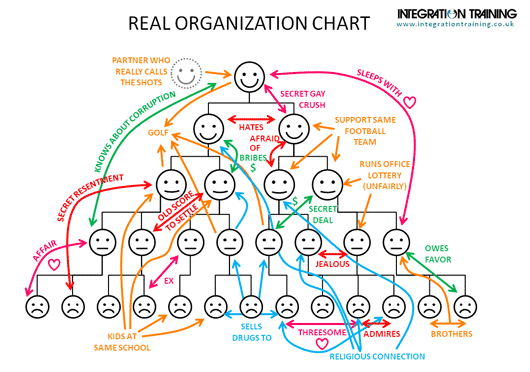Disguising Hierarchy Doesn’t Remove It
Summary Insight:
Holacracy isn’t boss-less—it’s rule-bound. If you’re thinking of deploying it, don’t be seduced by the hype. Understand the structure, the cost, and the leadership it actually demands.
Key Takeaways:
- Holacracy replaces hierarchy with roles, not freedom.
- Deploying it halfway guarantees failure—it’s all or nothing.
- You can cede authority, but don’t surrender leadership.
The headlines rolled across my feed like the credits on a blockbuster movie. Something big seemed to be happening but I wasn’t quite sure what to make of it. It seemed that Zappos—the popular business management poster child for happy employees and customers—just announced it was adopting some new-fangled “boss-less,” “hierarchy-less,” “structure-less” management system called Holacracy.
“Hola-what?” I said to myself as I started clicking links. Aimee Groth at Quartz wrote: “Zappos is going holacratic: no job titles, no managers, no hierarchy,” while the Washington Post headlined with, “Zappos Says Goodbye To Bosses,” and the Canadian Broadcast Company led with “Holacracy management style eliminates all bosses, titles.”
I’ve been around long enough to know that what the media was reporting would be far removed from the truth. I also had the inkling that the level of publicity that Zappos generates made it likely that Holacracy would become the next buzzword in management in 2014. Paul Herbert captured it well: “A new word crept into HR’s vernacular last week: holacracy. Better get used to seeing it.”
Each year I attend two personal/professional development workshops for my own education and growth. After trying to make sense of Holacracy through their website materials and recorded webinars, in the spirit of exploration I decided to dive deeper and make Holacracy one of my annual workshops. I signed up for their 1/2-day Taster Workshop followed by a 5-day Practitioner Certification Training in Las Vegas hosted by Holacracy founder Brian Robertson.
A few weeks later I hopped in my car to make the trek from my home in Santa Barbara across the desert to Vegas. The seminar turned out to be located just down the block from the Gold and Silver Pawn Shop of History Channel fame. As I drove by their shop at 1pm on a Friday, there was a line of people down the entire block. “Note to self,” I murmured while rubber necking the crowd, “this is what a reality TV can do for your small business.”
I parked and found my way to the seminar, located on the third floor of a secured building. I buzzed the intercom, walked up three flights of stairs, and entered the room where I’d spend the next week. I noted there were about 25+/- people gathered around circular conference tables and a standard lecture area at the front. I found a spot, put down my stuff and, with a mixture of curiosity and anticipation, made small talk with my fellow attendees, a surprising number of whom were French nationals, while waiting for the seminar to start.
Little did I know then what a struggle that entire week — and even several weeks after digesting my experience — would be for me. What did I struggle with? First, I found it really hard to try to unlearn what I’ve spent decades mastering and greet Holacracy with a Zen-like beginner’s mind. What could they teach me, really? Is the founder just using different terminology or is there a real difference in philosophy? And how do I maintain an anchor point in the real world and not get swept down a rabbit’s hole of theory?
The other struggle was that Holacracy is not an easy practice to learn. In fact, the nuances are such a challenge to master that a handful of the participants in my course were on their third or fourth attempt at the same training. At one-week long and $4K a pop, that’s quite an investment. As one of my fellow participants poignantly put it, “Holacracy is like a religion for dedicated monks to practice,” adding, “I wonder what the layman’s version will turn out to be?” I think this is an excellent question that time will reveal.
I’ve been home for several weeks now and I’ve had sufficient time to reflect on my total experience. In retrospect, there are several things I really admire about Holacracy. There are also key elements that, if I was an entrepreneur or CEO considering deploying Holacracy in my organization, I would supplement around the standard Holacracy script. While you don’t need Holacracy to create sustainable business transformation, I believe that these adaptations are necessary to get the most out of your investment and increase your probability of success should you choose to deploy it as a management framework.
What Is Holacracy, Exactly?
Before I explain what Holacracy is, let me first clear up some of the more blatant misconceptions in the media. Holacracy does indeed have de facto bosses or managers, albeit ones with circumscribed power. These roles are called “lead links” and they set the priorities and control resources in an organization. Holacracy also does have an explicitly defined hierarchical structure. It’s not one big kumbaya free-for-all. And when it comes to titles, well, Holacracy can either support or not support the use of titles. The key point here (with which I agree wholeheartedly) is that individual roles in an organization can and should shift over time and, as a result, job titles more often cause harm than good.
In my book Organizational Physics, I explain that all business and management theory — past, present, and future — can be reduced to some key driving principles. That is, while supposedly “new” theories and strategies come and go depending on the cultural zeitgeist, they’re all trying to provide solutions to the same core underlying problems. In some sense, these countless methods can be boiled down to a handful of approaches
If you’re already familiar with the principles of Organizational Physics, you can easily understand this explanation: Holacracy is an attempt to increase system integration and decrease system entropy by aligning Structure and Process (the bottom left and right sides of the Execution Diamond shown at the bottom of the map below) by applying a very high Stabilizing force (the S in PSIU):

If you’re not yet familiar with Organizational Physics, this definition probably won’t help you much, but the rest of this article will. And though of course I’m partial, I firmly believe that if you read my book Organizational Physics: The Science of Growing a Business, you’ll find it much easier to put the barrage of “new” trends in perspective.
In any case, in order to understand Holacracy it’s helpful to realize that you’re already living and working in a system that uses many of the core Holacratic principles. It’s the United States of America. Wait… what??? Yep, this cutting-edge management theory is actually built on some of the core principles of our government:
- The U.S. government has a constitution, and so does Holacracy. (In fact, one of the first tasks of a CEO when adopting Holacracy is to cede his or her authority to a Holacratic-based constitution).
- The U.S. government has a set of explicit laws or rules that attempt to govern individual and collective behavior, as well as a detailed process to change an existing “law” or create a new one, and so does Holacracy – very detailed.
- The U.S. government relies on a nested hierarchical structure of governing bodies (i.e., The Office of the President, Congress, the Supreme Court, the Military, States, Counties, Cities, City services, etc.) that act mostly autonomously within their own spheres. And so does Holacracy.
- We, the people, elect representatives to perform defined roles in our local, state, and federal governments. The members of a Holacracy-based organization also elect individuals to perform defined roles at different hierarchical levels or “circles” of the organization.
Holacracy’s approach to managing an organization is also very similar in ambition to the founding vision of the U.S government. The founding fathers tried to create a structure, processes, and checks and balances so that the government wouldn’t meddle in the affairs of law-abiding citizens but would instead allow people the autonomy to pursue their individual and collective interests.
For example, when you got up this morning, did you call President Obama and ask him for permission to buy groceries? Or did you call the mayor of your town and ask for the right to binge-watch House of Cards? Nope. You just did what was in your own interest, while staying within the system of rules and processes that have been adopted by your local, state, and federal government.
So Holacracy asks this question: If you don’t need a ruler to govern your financial and social life, then wouldn’t it be superior to design a business around a set of rules so there’s no need for rulers? What if an organization acted more like a modern city and less like a top-down feudal monarchy? As Holacracy founder Brian Robertson puts it, “Order doesn’t require rulers. And if you give one individual monarch-like authority, then it’s only a matter of time before they make a royal screw up.”
It may seem counterintuitive to compare the core operating principles of a supposed next-generation management theory to the operating principles of the U.S government. After all, doesn’t the U.S. government of recent decades seem to be more incompetent, and sometimes even nefarious, than innovative?
Look at it this way. We can all agree that the design of the U.S. government has the potential to create a competent and wise system of governance as well as a happy, well-educated, prosperous, and productive population of citizens. But a lot depends on its lifecycle stage (the U.S. is aging), its sense of shared vision and values (it’s fragmented), its resources (it’s broke), and most importantly the quality and caliber of the leaders who perform roles in the system over time (The U.S. now has an entire party of leaders like this guy). So we know that things can and do go wrong despite our best design intentions.
The same is true for Holacracy. It has the potential to be transformative but a lot depends on the organizational lifecycle stage of the business, the embodiment of shared vision and values, the organization’s resources and capabilities, and the quality and caliber of the people who inhabit the roles in the organization. In theory, Holacracy is a compelling and very thorough framework for managing structure and process in an organization. In practice, a lot can go wrong, just as with any framework.
To sum this all up, Holacracy is an attempt to bring a rigid but evolving set of rules, structure, and processes to how an organization is managed so that individuals have more clarity and autonomy to do their work (what Holacracy calls “energizing their roles”) in pursuit of the organizational purpose, without undue meddling from those above or below them in the organizational hierarchy.
How Does Holacracy Work?
To accomplish its purpose, Holacracy focuses on five key elements, what it calls the Holacracy Operating System:
-
- The Holacracy Constitution
Holacracy works by first having the CEO cede all legal authority to a new organizational Constitution. Holacracy provides a blueprint for the Constitution that the organization can modify for its particular needs and situation. This is where I warn you that you should not try to understand Holacracy by reading the Constitution. That would be like trying to learn a very complicated board game by reading the rule book. Instead, Holacracy encourages you to attend their trainings to learn how to “play the game” and then refer to the rule book when you have questions.
- Organizational Structure
The organizational structure in Holacracy is constantly evolving. It’s created and reinforced through a series of special meetings called the Governance Process. The key organizing element of a Holacracy structure is a circle that is made up of one or more organizational roles. The highest-level circle is the General Company Circle (GCC), which consists of all of the main roles or functions being performed in the company. For instance, an initial GCC might consist of roles from Sales, Operations, Finance, Accounting, Engineering, Marketing, and Product Management, as well as the former CEO role. From the GCC, sub-circles are created for each role. For example, Sales is part of the GCC but also has its own Sales Circle.
- Governance Meeting Process
Governance is where the organizational structure is created and evolved. Here the intent is to distribute authority and create organizational clarity about which roles are accountable for what. Holacracy doesn’t dictate what the structure should look like. It only stipulates how a role should be defined in the structure and how the members of a circle can adapt or change the roles within that circle to better serve the organization’s purpose. Most of the practitioner training is spent learning to navigate the nuances of the Governance meeting process. It starts out easy enough but the more you scratch the surface, the deeper it goes. If Holacracy was a board game, this is the stage when the players would get out the rule book (in this case the Constitution) and start interpreting and debating the rules. (This reminds me of Bismarck’s comment, “If you like laws and sausages, you should never watch either one being made”).
- Operations Meeting Process
Operations is how the day-to-day work of an organization is managed. In Holacracy, the focus of Operations meetings is to synchronize information flow and quickly triage what it calls “tensions.” A tension is a perceived gap between what is and what could be. Any member of the circle can bring a tension to the table and have it addressed. What’s peculiar to the Holacracy approach is that the circle doesn’t try to find the best way solve an issue, nor does it attempt to do so holistically by gathering data on all the issues related to that tension. It simply tries to resolve that one particular tension, in isolation, for that one role in the circle. This is done through a series of rigid steps that the circle must follow before it can reach a decision. In other words, it follows a process focusing on micro-level issue after micro-level issue, until, theoretically, all issues are resolved…ad infinitum.
- Glass Frog Software
Glass Frog is like a corporate wiki designed specifically for Holacracy. Glass Frog contains the organization’s constitution, a description of all roles, and the output of all governance and operations meetings. A Holacracy purist would argue that Glass Frog is not part of its core operating system and that a company could deploy Holacracy without it. I disagree. There is an overwhelming level of detail within Holacracy. There’s no way to track and manage it without a good system in place to do so, especially in a distributed environment.
Now that you’ve gotten the basics, the main question you should be asking is, “So what?” Or, “What is the real problem that Holacracy is trying to solve?” It’s the question I’m most commonly asked about Holacracy, and probably the best one of all. So let’s address it.
What is the Real Problem Holacracy is Trying to Solve?
In Holacracy webinars and trainings, the first thing participants learn is what’s wrong with the traditional, top-down org chart. Brian Robertson will put up this image below and ask the class, “What are some of the challenges created by the traditional, top-down organizational hierarchy?”
The class or group will offer up answers like, “painful meetings,” “difficulty to change,” “overwhelm,” “unclear objectives,” “misalignment,” “lack of engagement,” “rigidity,” “politics,” “analysis paralysis,” “bureaucracy,” “fear,” “communication issues,” and so on. All common issues that people are faced with in poorly-run organizations.
Once the top-down hierarchy is defined as the core problem of most organizations today, the Holacracy trainer will propose that rather than “bugs,” these failings are actually “features” of top-down organizational design. That is, no matter how much restructuring, leadership training, agile development methodologies, or other tactics we deploy, they are ultimately doomed to fail because of the inherent problems of the surrounding structure.
Holacracy claims to design out these “features” by changing the concept of organizational structure from one that is autocratic and top-down to one that is decentralized, organic, and bottom-up. Ultimately, the vision of Holacracy is to allow the emergent, creative properties of the individuals playing roles within an organization to self-organize and flourish, much like human cells are organized into organs, which in turn are organized into bodies and minds, which in turn go forth into the world to express their purpose as humans.
If all this sounds very theoretical and far-fetched to you, especially in the midst of the chaos and battle of growing your own business, I understand. Still, several aspects of the Holacratic approach are impressive…
What I Admire About Holacracy
There are several things that I admire about Holacracy. There is a clear sense of “we’re changing the world” that emanates from Holacracy insiders. Brian Robertson is a very smart, charismatic, and articulate founder, even though he discounts his own role in the formation, evolution, and operation of Holacracy and attributes these to Holacracy itself. (On this last point, I strongly disagree. All founders are mission-critical to the success and growth of their organizations into and through Scale It mode).
When I boil it all down, here are three of my favorite things about Holacracy:
A Relentless Focus on Roles vs. People
Holacracy does an outstanding job of distinguishing and reinforcing the difference between roles and people, which is a core principle of any good structure. In fact, Holacracy does NOT manage people. It governs roles. Every role has a clearly defined purpose and accountabilities that are maintained and defined in its GlassFrog software.
Naturally, one person could play any number of different roles in the organization. Companies that deploy Holacracy are constantly checking and updating GlassFrog to see what a role’s purpose is and what it is accountable for. If there seems to be a breakdown in how a circle is being run, that circle can call a Governance meeting and change or add a new role, thus changing the structure of the organization on the fly.
Separation of Working In vs. On the Business
Holacracy does a phenomenal job of distinguishing between tactical/triage issues that are handled in Operations meetings and structural/role issues that are handled in separate Governance meetings. This is also a core principle of any good management process. It’s crucial to strike a balance between the demands of today and the needs of tomorrow, and a sound process will enforce a regular rhythm of long-range development and short-range execution. Holacracy accomplishes this by not allowing a circle to discuss Operational issues in Governance meetings and vice versa. The result is that there’s a clear and regular focus between working in the business and working on the business. Awesome.
An Operating System vs. Apps
Holacracy envisions itself like the Apple iOS platform. Apple builds and maintains the iOS platform while millions of independent developers build individual apps that run on that platform. Holacracy clearly distinguishes itself as the core operating system for Structure and Process ONLY. It does not try to tackle “app development” in the areas of strategy, people or cultural development, hiring, finance management, marketing, budgeting, sales tactics, etc. Instead, it encourages others to develop apps that are designed to run on the Holacratic platform.
Note that this separation of “OS” and “Apps” has caused some confusion in the marketplace. For instance, a guru like Steve Denning will look for a relentless focus on delighting customers within the OS and he won’t like it unless it has that, or until he understands the purpose of Holacracy is to be applicable to any organizational purpose.
On the other hand, I’ll look for a relentless focus on lifecycle management in the OS, believing that the operating system must manage differently at different lifecycle stages. To me, that’s not an App; it’s part of the OS. A culture guru like Robbe Richman, who was also at my training, will look for alignment of vision and values and organizational buy-in in the OS itself and not consider that an App either, etc. So there will be differences of opinion on where the OS should start and end. However, I appreciate the discipline Holacracy has embraced by clearly sticking to what it defines as the OS: structure and process.
Should You Deploy Holacracy?
When it comes to making a decision whether to deploy Holacracy in your organization, the real question you should be asking is this: “Where is my business in its lifecycle development and what is the management operating system I need for its next stage of evolution?” The solution you choose will depend a lot on your personal philosophies as well as the cost to integrate, maintain, and evolve the new system.
I indicated earlier that Holacracy is not an easy solution to deploy. There were parts of the training I really enjoyed but much of it I found exhausting, unnatural, and frustrating to practice. I am not alone. I’m told by Holacracy insiders that the norm is for a new circle to experience serious levels frustration, condemnation, and aggravation when deploying Holacracy. Then, almost by magic, around the three-month mark something shifts: Holacracy begins to feels natural to circle members and starts to work as designed.
Personally, I like systems that feel natural and intuitive, so I spent much of the training trying to think through how to adopt the “good” parts of Holacracy and design out the “bad” parts. My conclusion? A half deployment will backfire. Each element of Holacracy feeds into and supports the rest. It needs to be a full commitment from the Constitution on down. It’s all entwined and you can’t make up a “light” version and expect the organization to respond differently than it already is. So if you’re going to deploy it, prepare for months of push-back, resistance, and aggravation before you find the breakthroughs you’re seeking.
Upon reflection, I think this difficulty in deploying Holacracy may be one of its strengths. Its full commitment “forces” the organization, from the CEO on down, to adopt and practice decentralized management and self-organization. That is, while you could likely get equivalent organizational benefits by running a Management By Objectives (MBO) system or Objectives and Key Results (OKRs) or the latest flavor of MBO, what you wouldn’t get from these systems is the constant reinforcement of the new social structures that Holacracy is designed to create.
Naturally, you’ll want to test out Holacracy in the senior level GCC circle before going company-wide. If you get this far, stick with it. I’m confident that, with a full commitment, Holacracy can help your organization rise to the next level, just as any good approach would when backed by a full commitment. The adaptions that I’m suggesting below still work within a full Holacracy deployment – meaning, that you are still deploying the complete Holacracy implementation for process and structure, without sacrificing some important principles in leadership, long-range planning, and organizational design. I believe that these adaptations will allow you to get the most out of a Holacracy implementation.
Adaptation #1: Don’t Abdicate the Master Structural Design
My experience growing businesses and coaching dozens of other successful growth businesses is that structure is about 85% of the game. That is, get your structural design right and you can create massive organizational transformation. Get it wrong and you don’t have a chance.
Holacracy allows for an organizational structure to be designed from the bottom up. Not only does this “organic” approach take a long time and is prone to egregious errors; it also allows for chaos where you need order and order where you need chaos.
For example, every city planner and architect knows that there are principles to good structural design. If you were to allow individuals to design whatever style of home or building they wanted, wherever they wanted it, it wouldn’t take long until you had fracking wells next to schools and a shanty towns next to city hall. There’s a great example of a leader, the Mayor of Oklahoma City Mick Cornett, who understands this and took charge of a poor city experience with haphazard future direction and redesigned it for prosperity, health, and success. Well-designed organizational structures, just like well-designed cities, are a boon to everyone who inhabits them.
I think that Holacracy adopted its bottom-up approach to structure because it confuses what are really problems with poor strategy, misaligned vision and values, ass-backwards decision-making processes, and poor leadership with problems with structure.
If you go back to the Holacracy critique of the top-down hierarchical “structure” (in which they really mean to say “org chart”), you’ll see that very few items actually relate to structure and none of them to structure alone: painful meetings (accountabilities and process), difficulty to change (accountabilities and process), overwhelm (process and strategy), unclear objectives (process and strategy), misalignment (strategy, vision and values, structure and process), lack of engagement (process and people), rigidity (strategy, structure, and process), politics (process and people), analysis paralysis (process), bureaucracy (process), fear (strategy, process, people), and communication issues (process).
A sound management system will address all of the issues raised by Holacracy and leverage, rather than discard, the principles of sound organizational design. Think about it. The purpose behind a top-down organizational design is not to command and control or to dictate, as its harshest critics would claim. It’s to clarify accountabilities, thus decentralizing authority, and allocate resources. It’s about getting the right style of people in the right roles with the right metrics and providing them the autonomy to flourish. It’s also about allowing new business units to innovate because of — not in spite of — a sound overall design.
So even if you do choose to implement Holacracy, I’d make damn sure that you have the right initial structure in place and that, as the leader, you keep an eye on it to make sure it’s not going katty-whampus and headed off a cliff. You need a structure that supports the strategy and current lifecycle stage, and clearly identifies the metrics, key performance indicators, and style of leader most suitable for each role. This is in addition to the purpose and accountabilities of each role that Holacracy will definitely help you to define.
One way to conceptualize this is for you, the entrepreneur or CEO (GCC Lead Link in Holacracy terms) to maintain control of the overall strategy as well as the master structure to support the execution of that strategy. You could accomplish this as an accountability within the GCC or even create a separate Strategy and Structure circle with those specific accountabilities. This approach would allow for self-organizing circles but within the master design. It’s kind of like being a master planner for a community garden. You lay out the plots (the functions) in the optimal way to take advantage of the terrain and climate and invite the community members to plant whatever they want, while still being accountable to produce results. JUST DON’T LET GO OF THE MASTER DESIGN OR YOU’LL SOON HAVE A PLOT OF CRAP INSTEAD OF A VIBRANT ECOSYSTEM.
If you’d like to understand the basics of designing a structure from the Organizational Physics perspective, read The 5 Classic Mistakes in Organizational Structure: Or, How to Design Your Organization the Right Way.
Adaptation #2: Don’t Confuse the Tensions for the Cause
Holacracy Governance and Operations meetings have a relentless focus on solving tensions held by any role in the circle. So if you were the VP of Sales and had a tension with how Marketing was allocating its resource dollars to lead generation, you could bring that tension to the circle and have it processed.
In order to process the tension, the Holacracy trained facilitator would guide the circle through a series of prescribed steps to resolve the issue in such a way that your tension is satisfied (hopefully) but without harming the autonomy of any other role in the circle. How rigid are these steps? Very. There’s no discussion allowed of issues that might be related. There is only a focus on processing one tension at a time for the role that brought it to the circle. There is a set of rules about who speaks when and what is allowed or not allowed as a valid objection to any proposal. It’s a lot like practicing law in a courtroom.
Processing tensions is important. There’s always a gap between what is and what could be. However, the way the decision-making process is structured in Holacracy actually reverses what’s required for rapid execution. As I describe in Organizational Physics, organizational mass (resistance to change) is a real thing. In order to execute fast, you need a process that slows down enough up front (in the decision-making phase) to gather a diversity of opinions and sufficient data so that you make a good decision with full commitment. Then you can go fast on implementation. Holacracy reverses this model. It focuses on rapid decision making at the cost of rapid implementation. Exactly the opposite of what, in my opinion, a well-run decision making process should do.
To clarify, I’m not condoning pushing off making decisions. I’m also not condoning a poor decision-making process that allows for a free-for-all. The structure and process of meetings is critical to good management. But the right structure and process will support making sound, well-thought decisions that afterward get implemented quickly rather than rushed, half-baked decisions that fail on implementation. (If you’d like to learn more about the basics of a good-decision making process, read The Most Important Process in Your Business: Or, How to Make Good Decisions and Implement Them Fast.
In many later-stage, bureaucratic-heavy institutions like large businesses, governments, schools, and non-profits, I think that Holacracy could be a productive change. In these settings, there’s already a bias towards not making a decision, following the political winds, and covering your ass in the face of a stolid bureaucracy.
In short, these settings already have a high-Stabilizing force at work within them. Holacracy will match the Stabilizing force within these institutions well and, if executed correctly, it will shift the culture towards decision making, accountability, and action — any action. Because the risk of making a bad decision is low in these settings, versus the risk of not making a decision at all, it could be a helpful management practice to adopt.
However, in most expansion-stage companies (the area where I specialize), there’s actually a bias in the other direction. Here, companies usually confuse making rapid decisions with making rapid progress. Rather than speeding through to a one-off decision, they need to cultivate the muscle to find the underlying cause of every challenge. In short, they need to slow down in order to go fast. So be mindful of this if you adopt Holacracy. You’ll need to supplement it with long-range strategic development practices so that once or twice a year you pattern up all the tensions, identify their underlying causation, and put in place efforts to solve them at the root level.
Adaptation #3: You Can Renounce Your Authority But Don’t Cede Your Leadership
If you’re going to truly adopt Holacracy then you, as the CEO, will be asked to sign over your authority to a Holacratic-based Constitution, much as the President of the United States takes an oath to defend the U.S. Constitution.
Is this ceremony? Yes. Is it necessary? If you’re going to make a full commitment, then yes. But even if you do choose to sign over authority, make sure that you’re not also forgoing your own authentic leadership.
Let me put it this way. According to Holacracy, if the CEO just cedes authority to the Constitution up front, then the Holacractic system will take over and the organization will transform. It’s not a requirement for an organization to have great leadership, it’s only a requirement that they adopt Holacracy. Then, by virtue of its “exquisite design,” the organization will begin to transform.
This principle reminds me of Communism, which reads well in theory but utterly fails in implementation. The fact is that bad leaders make bad systems. A poor leader will attempt to execute on the wrong strategy, will allow misaligned vision and values, will disregard the principles of structure and process, or will place the wrong style of people in the right roles. If this is the case, then that business is going to fail anyway and Holacracy, or any other management system, is not going to prevent disaster.
On the other hand, a great leader builds sustainable systems. He or she will take what they’ve got and make any system work well, Holacratic or not. If you look at the most successful businesses in history, the ones that assume almost transcendent, iconic status — IBM, Apple, Ford, Disney, Walmart, Standard Oil, HP, Intel, Coca-Cola, Microsoft, Google, Amazon, Virgin, etc. — you’ll see that while each founder had his own unique approach and management methodology, each also designed their business to be symbiotic with his or her own innate genius.
These visionary founding leaders did what only they could do in the early stages of their business growth and beyond. They consciously designed their businesses around their own innate ability to innovate and made conscious design choices to offset their weaknesses. They influenced the most important things without getting bogged down in the details. They delegated, but with visibility and control. They surrounded themselves with complementary teams and structures. They ensured that good decisions got made and implemented quickly time and again, not by micro-managing details but through systems thinking. These same principles hold true for you.
Can you use Holacracy to create this kind of sustainable business growth over time? Absolutely. Do you need Holacracy to do so? Absolutely not. If you look again to the Organizational Physics map, you’ll see that there are many methods to manage your business, and they all come back to the basics. Set the right innovation strategy. Define the vision and defend the right values. Craft and realign the structure to support the evolving strategy. Use this structure to clearly distribute authority and accountability. Follow a sound decision-making process. Design for self-organizing teams with the freedom and autonomy to execute and backed with clear metrics. Get the right people in the right roles. Work on the long range and execute on the short range. Know the forces at play. You know — do the basics right.
Time will tell the fate of Holacracy in the changing winds of the marketplace. However that goes, I want to give kudos to the entire Holacracy team for their commitment to a big vision and for pushing the envelope. They’ve clearly chosen to do what they feel is right versus what is easy or expedient. As anthropologist Margaret Mead said, “Never doubt that a small group of thoughtful, committed people can change the world; indeed, it’s the only thing that ever has.” I look forward to learning more as Holacracy continues to develop.





